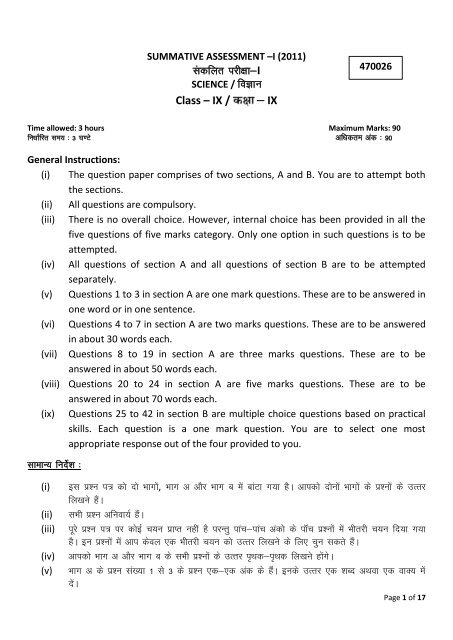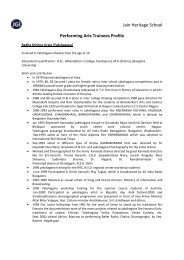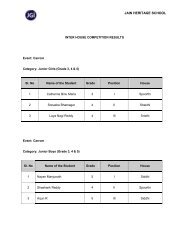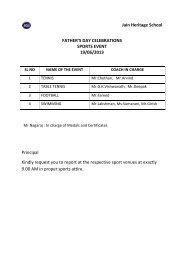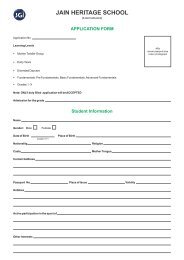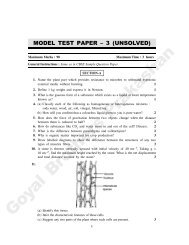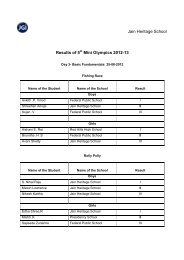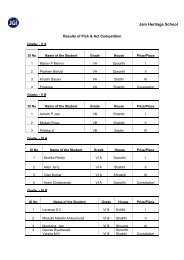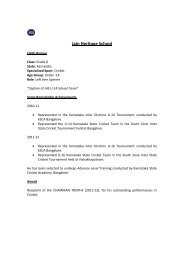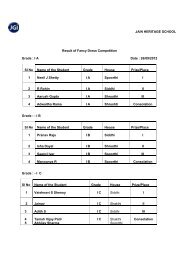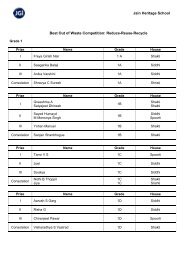SUMMATIVE ASSESSMENT âI (2011)
SUMMATIVE ASSESSMENT âI (2011)
SUMMATIVE ASSESSMENT âI (2011)
You also want an ePaper? Increase the reach of your titles
YUMPU automatically turns print PDFs into web optimized ePapers that Google loves.
this tissue.(a)(b)16. (a) Identify the given figures.(b)(c)State in brief their structure.Describe the role performed by the two.(a)(b)(c)Page 5 of 17
17. What are chromoplasts and leucoplasts ? Give an example of chromoplasts which hasgreen pigment.18. (a) Why are manures and fertilizers used in fields ?(b) What are the long term benefits of using manure in crop production ?(a)(b)19. A farmer wants to store his agricultural produce. What are the factors that he should checkbefore storing it ? What are the control measures that he should take ?20. (a) What is meant by crystallisation ? How is impure copper sulphate purified by theprocess ?(b) What is fractional distillation ? How is it different from simple distillation ?(a)(b)ORShow diagrammatically how water is purified in the waterworks system and list theprocesses involved.21. What is evaporation ? In the following examples state which factor is responsible 5for the change in rate of evaporation and how ?(i)(ii)Clothes dry faster on a windy day.Wet clothes dry faster on spreading them.Page 6 of 17
(iii) Clothes dry faster in sun than in shade.(iv) Clothes take longer time to dry on a rainy day.(i)(ii)(iii)(iv)ORDistinguish, in tabular form, between solids, liquids and gases under the followingcharacteristics :(i)(ii)Intermolecular attractiondensity(iii) fluidity(iv) Diffusion(v)Kinetic energy of particles at a given temperature(i)(ii)(iii)(iv)(v)22. State law of conservation of momentum. Prove this law for a head on collision of two balls, 5using the laws of motion.ORPage 7 of 17
(a) Define force and give its S.I unit. 5(b)For an object of mass 2 kg the velocity - time graph is given below. Find the forceexperienced by the object during motion represented by the graph - OA, AB and BC.(a)S.I.(b)2 kgOA, ABBC23. On a 100 km track, a train travels the first 30 km at a uniform speed of 30 km h 1 . Howfast must the train travel the next 70 km so as to average 40 km h 1 for the entire trip.100 km 30 km 30 km h 170 km 40 km h 1A body moves with a velocity of 2 m/s for 5 s, then its velocity increases uniformly to 10m/s in next 5 s. Thereafter its velocity begins to decrease at a uniform rate until it comesto rest after 5 s.OR(a)Plot a velocity - time graph for the motion of the body.(b) From the graph find the total distance covered by the body after 2 s and 12 s.5 s 2 m/s 5s10 m/s 5sPage 8 of 17
(a)(b) 2 s 12 s24. Explain different kinds of irrigation systems adopted to supply water to agricultural lands.ORWhat are weeds ? Why is the removal of weeds necessary during cultivation of crops ?Mention two methods of weed control.Section B25. A solution when kept for some time formed two layres. The solution cannot pass through thefilter paper. It is a :(a) Saturated true solution (b) Suspension(c) Colloid (d) Unsaturated true solution(a)(c)(b)(d)26. Which of the following will not leave a residue on filter paper ?(a)(b)(c)(d)Sulphur powder mixed in water.Starch mixed in cold water.Copper sulphate mixed in water.Sand mixed in water(a)Page 9 of 17
(b)(c)(d)27. X is a mixture of iron filings and sulphur and Y is a product obtained by heating themixture X and crushing it to a fine powder. On bringing a magnet over both X and Y,Rahul observed that :(a)(b)(c)(d)X and Y both are attracted.X is attracted while Y is not.Y is attracted while X is not.Both X and Y are not attracted.X Y XX Y(a) X Y(b) X Y(c) Y X(d) X Y28. During an experiment a metal strip when burnt in the flame produces white dazzling light.The metal is :(a) sodium (b) potassium (c) zinc (d) magnesium(a) (b) (c) (d)29. In the determination of melting point of ice, a student observed with the help of thermometer,that :Page 10 of 17
(A)(B)(C)(D)whole of ice melts and temperature starts decreasing.Ice starts melting and temperature becomes constantice starts melting and temperature starts rising.temperature starts rising but ice does not melt.(A)(B)(C)(D)30. Following set of observations were made during the determination of boiling point of water.S. N. Time (min) Temp ( C)1. 5.0 98.02. 7.0 98.53. 9.0 99.54. 11.0 99.55. 13.0 99.56. 15.0 100.07. 17.0 99.58. 19.0 99.5From these observations, it may be concluded that the boiling point of water is :(A) 98.0 C (B) 99.0 C(C) 99.5 C (D) 100 CPage 11 of 17
(C)1. 5.0 98.02. 7.0 98.53. 9.0 99.54. 11.0 99.55. 13.0 99.56. 15.0 100.07. 17.0 99.58. 19.0 99.5(A) 98.0 C (B) 99.0 C(C) 99.5 C (D) 100 C31. In the experimental set up shown in the figure the missing item in the set up is :(a) Thermometer (b) Two holed cork(c) One holed cork (d) Cotton plugPage 12 of 17
(a)(b)(c)(d)32. What is observed first, when a mixture of iron filings and sulphur powder is heated in a chinadish ?(A) Sulphur starts melting (B) Mixture becomes red hot(C) Iron starts melting (D) Mixture evaporates(A)(B)(C)(D)33. Student ‘X’ puts Fe nails in CuSO 4 solution while the other student ‘Y’ puts Cu pieces in FeSO 4solution. The observation that solution turns green from blue colour is reported by :(a) student ‘X’ (b) student ‘Y’(c) Both students ‘X’ & ‘Y’ (d) None of them‘X’(FeSO 4)‘Y’(a) ‘X’ (b) ‘Y’(c) ‘X’ ‘Y’ (d) ‘X’ ‘Y’34. To separate a mixture of sodium chloride and ammonium chloride the most commonlytechnique used in school laboratories is :(a) evaporation (b) distillation (c) sublimation (d) filtrationPage 13 of 17
(a) (b) (c) (d)35. A student recorded the mass of dry raisins as 2.5g and the mass of raisins after soaking inwater as 4.0g . While performing the above experiment. The percentage of water absorbed byraisin is :(a) 20% (b) 30% (c) 60% (d) 40%2.5g 4.0g(a) 20% (b) 30% (c) 60% (d) 40%36. On observing onion peel slide under low power of compound microscope the structures clearlyseen are :(A)(B)(C)(D)Cell wall, cell membrane, nucleus, cytoplasmNucleus, cell membrane, vacuole, chromosomesCell wall, cell membrane, nucleus, plastidsCell wall, cell membrane, cytoplasm, mitochondria(A)(B)(C)(D)37. Given below are the four methods of testing the presence of metanil yellow in a given sampleof arhar dal. The correct method is :Page 14 of 17
(a)(b)(c)(d)5 g of dal is added to 5 g of metanil yellow.5 g of dal is added to 5 mL of water and 2 drops of conc HCl.5 g of boiled dal is added to 5 mL of water.5 g of boiled dal is added to 5 g of metanil yellow.(a) 5 5(b) 5 5(c) 5 5(d) 5 538. The four operations for testing the presence of starch in rice are given below.(1) Put few grains of rice in a test tube(2) Add few drops of iodine solution(3) Add water to the test tube containing rice(4) Boil the rice and filter the contentsThe correct sequence of operations is :(a) (1), (2), (3), (4) (b) (1), (3), (4), (2)(c) (1), (3), (2), (4) (d) (1), (2), (4), (3)(1)(2)(3)(4)(a) (1), (2), (3), (4) (b) (1), (3), (4), (2)(c) (1), (3), (2), (4) (d) (1), (2), (4), (3)Page 15 of 17
39. Cheek cells after observing under a microscope may be classified as :(A) glandular epithelial cells. (B) squamous epithelial cells.(C) cuboidal epithelial cells. (D) columnar epithelial cells.(A)(B)(C)(D)40. Intercellular space is generally available in : 1(a) Parenchyma cells (b) Collenchyma cells(c) Sclerenchyma cells (d) All of the above(a)(c)(b)(d)41. A student soaked 1.0 g raisins in 15 mL of distilled water in two beakers A and B. Hemaintained beaker A at 20C and beaker B at 40C. After an hour, the percentage of waterabsorbed will be :(a) Same in beaker A and B (b) more in A than in B(c) more in B than in A (d) twice as much in B as in A1.0 g 15 mL A B A 20CB 40C 1(a) A B (b) A B(c) B A (d) B A42. Out of the following, the tissue whose cells are dead is : 1(a) Collenchyma (b) Sclerenchyma(c) Parenchyma (d) PhloemPage 16 of 17
(a)(c)(b)(d)Page 17 of 17


